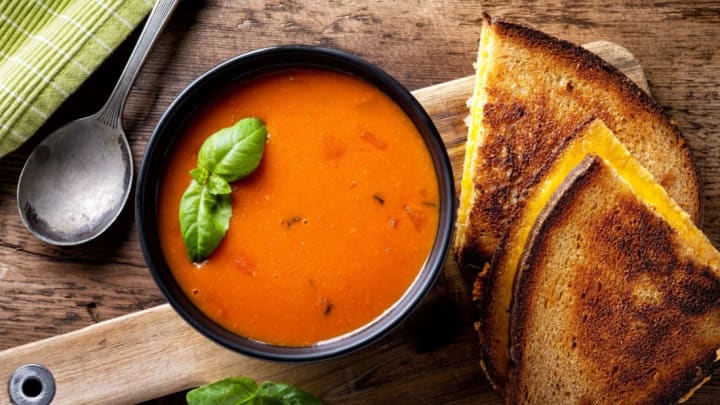Finding the right temperature for soup can be difficult. On one hand, few culinary experiences are as unsatisfying as sipping on a lukewarm broth. On the other hand, nobody enjoys burning their taste buds on nuclear-heated stock. Luckily, you can embrace your inner Goldilocks and find a soup temperature that’s “just right”—with science!
Studies confirm what chefs have long suspected: Temperature affects the taste of food. Cheddar cheese generally tastes more sour when warmed, while a savory ham will seem saltier as it cools. The reasons for these flavor differences are complex; sometimes they’re caused by receptors on the tongue and other times by chemical changes in the food itself. Research shows that some foods are epigenetically altered when heated or cooled. Tomatoes, for instance: The genes that help express a tomato’s full flavor profile are “turned off” when exposed to cool temperatures. That’s why some cookbooks warn not to refrigerate them.
The same principles also apply to soup. Different temperatures can accentuate, or dull, different aspects of a stock’s flavor profile.
In 2017, researchers in Spain published a study in the International Journal of Food Properties that tested the incidence of taste compounds—such as amino acids and nucleotides—in a traditionally cooked chicken broth. Samples were cooked for three to five hours, with temperatures ranging from 86°C to 103°C (that’s 185°F to 217.4°F). The team discovered that taste compounds, including those associated with umami, increased with temperature. Flavor compounds were also boosted by longer cooking times, but the effect was temperature-dependent.
In other words, the hotter the soup, the more flavorful it can be. It’s important, however, to make a distinction between cooking temperature and serving temperature. Nobody should serve soup at 217°F. Skin exposure to a liquid over 150°F can cause burns almost instantly [PDF]. There’s no point in boosting the umami of your soup if you can’t feel your tongue.

As soup cools, its flavor profile will change. According to a 2016 study in the journal Chemical Senses, umami flavors will deteriorate as a soup drops to (and below) room temperature. It will also taste saltier. This phenomenon is described in a handful of other studies, including a 2015 work published in the journal Appetite. In that study, researchers asked eight trained panelists and 62 untrained panelists to rate the saltiness of salt water, chicken broth, and miso soup. Temperatures ranged from 40°C to 80°C (104°F to 176°F). The trained panelists perceived no difference in the saltiness of the hot and lukewarm soups, but the Average Joes said the colder soups tasted saltier (the study didn’t go into the reasons why, however).
Temperature also affects other flavors. A 2012 study in Chemosensory Perception showed that sourness was most intense when a solution was warm and bitterness most intense when it was cold. Other studies show that our perception of sweetness is enhanced with cold foods, which may explain why frozen treats such as ice cream can taste sickly-sweet when melted [PDF].
But back to our original question: How do I find the ideal temperature for serving soup?
The annoying answer is: It depends! It depends whether you prefer a bowl that’s a pinch salty, a smidge umami, or something else. It also depends if you’re among the 20 percent of people who are “thermal tasters” most sensitive to food temperature. Among this group, “heating or cooling small areas of the tongue draws out a taste sensation without the presence of food or drink,” according to a press release about the Chemosensory Perception study.
Generally, the best serving temperature probably hovers around the pain threshold for the tongue, which is approximately 153°F [PDF].
There are a few reasons why. Most people will want to serve their soup at the warmest temperature possible without causing pain. Our taste buds contain small, heat-sensitive proteins called TRPM5 channels, which are important for the perception of umami and perform best when food is warm. High temperature foods also emit more aromas, an important factor that amplifies the intensity of taste. “As heat is applied to food, its essential oils, or volatiles, are released, which increases the food’s aroma and flavor,” food writer Amanda Hesser explains in The New York Times. As a hot dish cools, the flavors change and develop. She also suggests contrast, like topping hot chili with cool sour cream, to animate taste receptors.
Scientists have done a lot of research about where to draw the line between a liquid that’s “just right” and “too hot”—and a temperature ranging between 136°F to 162°F appears to be the best bet, according to a recent analysis in The Journal of Food Science. For soup-lovers, anything significantly warmer than 170 degrees will probably require tiny sips and spoon-blowing. Anything cooler than 130 might feel merely warm. Something in between should satisfy your taste buds without destroying them.
